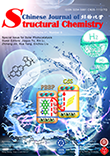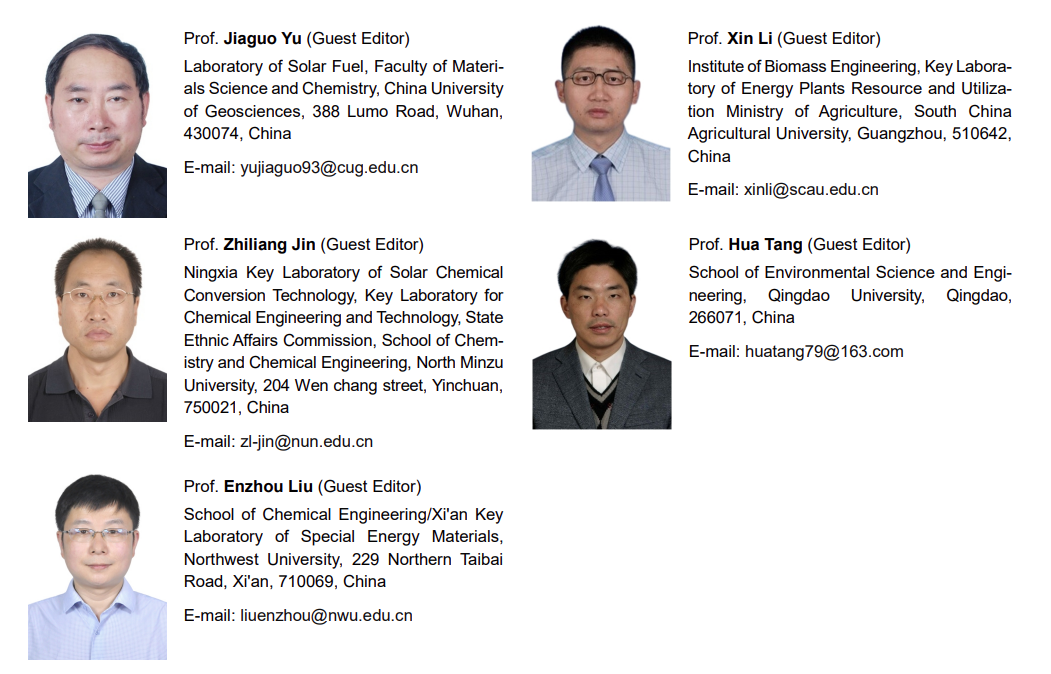
Preface to Solar Photocatalysis
Jiaguo Yu*, Xin Li*, Zhiliang Jin*, Hua Tang* and Enzhou Liu*
Chin. J. Struct. Chem. 2022, 41, 2206001-2206002
June 20, 2022
Solar Photocatalysis
ABSTRACT
Solar energy is the most important clean and renewable energy in the world. However, the unpredictability, seasonal variation day and night, uneven distribution and low energy density limit its practical application. Photocatalysis technology has a very broad application prospect in solving energy and environmental problems. Photocatalysis can use sunlight to decompose water to produce hydrogen, and convert light energy into storable chemical energy-hydrogen energy. Hydrogen energy has high energy density and is considered as an ideal energy carrier. Photocatalysis can also use sunlight to convert carbon dioxide into methane and methanol fuel to achieve the purpose of energy conservation and emission reduction. However, because of low photocatalytic efficiency, the energy and environmental applications of various photocatalytic materials and technologies are still very limited. Thus, various improvement and investigations are highly required from the viewpoint of practical utilization.
This special issue contains 11 papers, which are mainly related to hydrogen production, CO2 reduction and pollutant degradation. Among them, 4 papers are related to the preparation of S-scheme heterojunction photocatalyst. We would like to express our sincere thanks to all the authors for submitting their interesting works to this special issue. A brief summary of all 11 accepted papers is provided as follows.
Firstly, in “Research Highlight: Molecular-level Engineering of S-scheme Heterojunction: the Site-specific Role for Directional Charge Transfer”, a novel atom-specific tailoring strategy was introduced on the construction of S-scheme heterojunction for promoting the transfer and separation of photogenerated carriers. The S-scheme heterojunction is composed of high-crystalline g-C3N4 with Co-doped CeO2. Co-doping enhances the directional electron-driving effect towards functionalized Co sites, benefiting for effective CO2-to-CH4 photoreduction.
The paper “Enhanced Photocatalytic H2-production Activity of CdS Nanoflower using Single Atom Pt and Graphene Quantum Dot as dual Cocatalysts” reports the fabrication of hierarchically nanostructured CdS/GQDs/PtSAs composite photocatalysts by a simple microwave-hydrothermal method followed by lyophilization and in-situ photocatalytic reduction method. The prepared CdS/GQDs/PtSAs photocatalyst exhibits enhanced and durable visible-light photocatalytic H2 production performance (13488 μmol h-1 g-1) compared to pure CdS, CdS/GQDs, and CdS/PtSAs samples. The prepared photocatalyst also achieves apparent quantum efficiency of 35% at 420 nm and an energy conversion efficiency of 13.05%.
The paper “S-scheme Porous g-C3N4/Ag2MoO4 Heterojunction Composite for CO2 Photoreduction” describes a novel S-scheme ultrathin porous g-C3N4(UPCN)/Ag2MoO4 (AMO) composite prepared by in-situ growing tetragonal α-AMO nanoparticles (NPs) (5-30 nm) on UPCN nanosheets (NSs). The S-scheme charge transfer route endows UPCN/AMO with fast charge separation and strong redox capability. The UPCN/AMO composite exhibits enhanced CO2 photoreduction performance with CO and CH4 yield rates of 6.98 and 0.38 μmol g-1 h-1, which are 3.5 and 2.9 folds higher than that of pristine UPCN, respectively.
The paper “Simultaneous Photocatalytic Oxygen Production and Hexavalent Chromium Reduction in Ag3PO4/C3N4 S-scheme Heterojunction” presents the fabrication of Ag3PO4/C3N4 heterojunction by in-situ coupling Ag3PO4 particle with C3N4 hollow spheres using a precipitation method. The Ag3PO4/C3N4 heterojunction could synchronously realize high photocatalytic oxygen production and hexavalent chromium reduction. The charge transfer of the composite follows the S-scheme charge transfer mechanism driven by the formed internal electric field, which accelerates the photogenerated carrier separation and retains high photoredox ability. The optimized composite affords a high oxygen production rate of 803.31 µmol·g-1·h-1 and 87.9% conversion of Cr(VI).
In “Pyrene-benzothiadiazole-based Polymer (PBBP)/CdS 2D/2D Organic/Inorganic Hybrid S-scheme Heterojunction for Efficient Photocatalytic H2 Evolution”, a PBBP-based polymer/CdS 2D/2D organic/inorganic S-scheme heterojunction photocatalyst with a strong internal electric field was prepared for efficient photocatalytic hydrogen evolution. The prepared composite S-scheme heterojunction photocatalyst exhibites the highest H2-production rate of 15.83 mmol h-1 g-1 on 20% PBBP/CdS composite under visible-light irradiation, nearly 2.7 times higher than that of pure CdS. The apparent quantum efficiency (AQE) of 20% PBBP/CdS composite could reach 8.66% at λ = 420 nm. The enhanced activity could be attributed to the construction of S-scheme heterojunction, which accelerates the recombination of carriers with weaker redox ability and maintains the strong reducibility of electrons in CdS.
The paper “Ag2S Quantum Dots Decorated on Porous Cubic-CdS Nanosheets Assembled Flowers for Photocatalytic CO2 Reduction” reports the preparation of CdS-Ag2S composite by assembling Ag2S QDs cocatalyst on the surface of CdS nanosheet-assembled flower using oil-bath solvothermal method. The composite with 5 wt% Ag2S QDs loaded achieves CO evolution rate of 16.6 μmol·g-1·h-1 without noble-metal cocatalysts. This strengthened photocatalytic performance and photocatalytic stability are attributed to the energy band broadening of Ag2S QDs caused by quantum size effect and the large specific surface area due to the assembled flower.
The paper “Molecular Engineering of g-C3N4 with Dibenzothiophene Groups as Electron Donor for Enhanced Photocatalytic H2-Production” reports dibenzothiophene (DBT)-4-carbaldehyde as the precursor introduced into g-C3N4 (TCN) prepared by two-step thermal polymerization to construct an intramolecular donor-acceptor (D-A) type copolymer (TCN-DBTx). The incorporation of DBT not only adjusts the band gap to improve reduction ability, but also induces an internal electric field with extending π-conjugated system for effective charge transfer. As a result, TCN-DBTx exhibits much better photocatalytic performance with an optimal hydrogen production rate of 3334 μmol h-1 g-1, which is 2.5 times that of TCN.
The paper “Asymmetric Structure Awakened n-π* Electron Transition in Sulfur and Selenium Co-doped g-C3N4 with Efficient Photocatalytic Performance” describes sulfur and selenium co-doped graphitic carbon nitride (SSCN) prepared via synchronously introducing sulfur and selenium atoms into the melon structure of g-C3N4. The as-prepared SSCN possesses a larger specific surface area with a richer pore structure that provides more active centers for catalytic reaction. The asymmetric structure of SSCN due to introducing sulfur and selenium not only maintains the easier activation of π-π* electron transition but also awakens the n-π* electron transition in g-C3N4. SSCN-50 shows the best photocatalytic performance, achieving 78.0% and 99.4% degradation of antibiotics (TC) and organic dyes (RhB), which is 2.5 and 16.8 times higher than the vaules for g-C3N4, respectively.
In “K2HPO4-mediated Photocatalytic H2 Production over NiCoP/RP Heterojunction”, bimetallic NiCoP nanoparticles (NPs) were prepared via a solvothermal method using red phosphorus (RP) as P source, and it is combined with red phosphorus (RP) nanosheets via a physical grinding process. NiCoP has better charge transfer ability and faster H2 releasing kinetics than the corresponding single metal phosphides alone. 6 wt% NiCoP/RP exhibits an excellent H2 evolution activity in 20 vol.% triethanol-amine/water solution under a 300W Xe-lamp irradiation, and the corresponding H2 production rate is 1535.6 μmol·g-1·h-1, which is 7.4, 3.2 and 2.6 times higher than those of pure RP, 6 wt% Co2P/RP and 6 wt% Ni2P/RP, respectively. When appropriate K2HPO4 is introduced into the reaction solution, the H2 production rate of 6 wt% NiCoP/RP is further boosted from 1535.6 to 2793.9 μmol·g-1·h-1 due to the easier combination between H+ and electrons with the assistance of HPO42-.
The paper “Bi and S Co-doping g-C3N4 to Enhance Internal Electric Field for Robust Photocatalytic Degradation and H2 Production” presents the preparation of template-free self-assembled Bi and S co-doped g-C3N4 sample by two-step elevated temperature calcination and solvothermal reflux method. It is found that the introduction of appropriate concentration of Bi and S into the skeleton structure of g-C3N4 can achieve efficient degradation of tetracycline (TC) and other pollutants in the liquid environment and excellent photocatalytic H2 evolution performance (1139 μmol·L-1·h-1).
Finally, in “Ingenious Design of
CoAl-LDH p-n Heterojunction Based on CuI as Holes Receptor for Photocatalytic
Hydrogen Evolution”, p-n heterojunction of 2D/3D structure is constructed by
the nanosheet of CoAl-LDH and rock-like CuI. The introduction of CuI can make
CoAl-LDH disperse better, which brings more reaction sites for the hydrogen
evolution reaction. The activity of composite catalyst (CI-10) reaches a
maximum of 3.59 mmol g-1 h-1 which is 28.5 times higher
than that of CuI.






